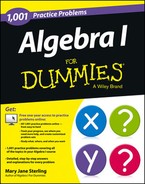Chapter 3
Working with Fractions and Decimals
Fractions and decimals are closely related. A fraction can be expressed as either a repeating or terminating decimal. A decimal is a special type of fraction — it always has a denominator that's some power of ten. Decimal numbers are often written with a lead zero. You'll see 0.031 instead of .031. The lead zero helps keep the decimal point from getting overlooked.
The Problems You'll Work On
In this chapter, you'll work with fractions and decimals in the following ways:
What to Watch Out For
Don't let common mistakes trip you up; remember the following when working with fractions and decimals:
Adding and Subtracting Fractions
91–96 Find the sums and differences of the fractions.
91. ![]()
92. ![]()
93. ![]()
94. ![]()
95. ![]()
96. ![]()
Multiplying Fractions
97–100 Multiply the fractions and mixed numbers.
97. ![]()
98. ![]()
99. ![]()
100. ![]()
Dividing Fractions
100–104 Divide the fractions and mixed numbers.
101. ![]()
102. ![]()
104. ![]()
Simplifying Complex Fractions
105–110 Simplify the complex fractions.
105. ![]()
106. ![]()
107. ![]()
108. ![]()
109. ![]()
110. ![]()
Adding and Subtracting Decimals
111–114 Find the sums and differences of the decimal numbers and variable expressions.
111. 432.04 + 6.0001 =
112. 15.4 − 5.123 =
113. x + 0.043x =
114. 5.3y − 4.712y =
Multiplying Decimals
115–118 Find the products of the decimal numbers and variable expressions.
115. 4.3 × 0.056 =
116. 6.21(−5.5) =
118. 3.7y(−4.5y)(−0.1y) =
Dividing Decimals
119–124 Find the quotients of the decimal numbers. Round the answer to three decimal places, if necessary.
119. 36.5 ÷ 0.05 =
120. 0.143 ÷ 1.1 =
121. 6 ÷ 0.0123 =
122. −72 ÷ 3.06 =
123. 1.45 ÷ 0.03 =
124. 67.4 ÷ 0.037 =
Changing Fractions to Decimals
125–132 Rewrite each fraction as an equivalent decimal.
125. ![]()
126. ![]()
127. ![]()
128. ![]()
130. ![]()
131. ![]()
132. ![]()
Changing Decimals to Fractions
133–140 Rewrite each decimal as an equivalent fraction.
133. 0.75
134. 0.875
135. 0.0008
136. 0.1525
137. 0.888...
138. 0.636363...
139. 0.261261...
140. 0.285714285714...
